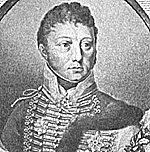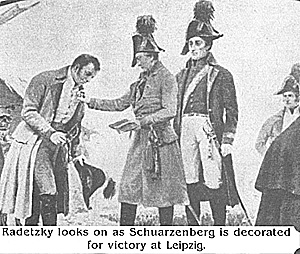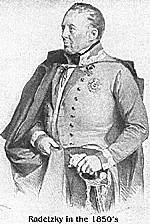 Played annually at the Vienna New Year Concert, the 'Radetzky
March', written by Johann Strauss the Elder in 1848, ranks as one of the
most famous pieces of military music ever. It marked the culmination of
a military career extending over 64 years through wars with the Turks,
Napoleon and the rebels of 1848.
Played annually at the Vienna New Year Concert, the 'Radetzky
March', written by Johann Strauss the Elder in 1848, ranks as one of the
most famous pieces of military music ever. It marked the culmination of
a military career extending over 64 years through wars with the Turks,
Napoleon and the rebels of 1848.
Born on 2nd November 1766 in Bohemia, Radetzky came from a minor noble family. Influenced by the military from the start, his father being a Hauptmann (Captain) in the Imperial Army, at just six, Josef was an orphan living in Prague with his grandfather, on whose death he inherited the title Count Radetzky von Radetz in 1781. His uncle continued to encourage Josef towards the military and after joining the Empress Maria Theresa cavalry school in Vienna, at the age of 17, Radetzky was appointed as a cadet to the Carmelli Kurassier, (29th Cavalry regiment).
After appointment as an Oberleutnant (1st Lieutenant) in November 1787, Josef saw his first action with the field army against the Turks around Belgrade during the following year. Initially, the war went badly for the Austrians, but the arrival of Feldmarschall Laudon turned the tide in 1789. It was fortunate for the young Radetzky too: following a short spell as an Adjutant in Imperial headquarters, he was then seconded to Laudon, who rated him highly and predicted a great future for him.
Having experienced the effect of massed artillery and mounted in the field, Radetzky returned to regiment and resumed his studies. I saw him on the Empire's distant borders again at the start of the French Revolutionary wars in Belgium, but after a short time in headquarters, the now 27-year-old returned to active duty, leading a six-men Kurassier patrol in a night swim both ways across the Sambre river, to reconnoitre French positions around Charleroi. The successful completion of this mission brought promotion to Rittmeister (cavalry captain).
 For a while, his good luck disappeared. Wounded lightly twice
in the head at Fleurus (26th June 1794) and in the shoulder at Mainz
(29th October 1795), he was then dispatched to Italy to face
Bonaparte's first Italian campaign. It would also provide
Radetzky with a new opportunity and his longest command. The
difficult watery terrain of northern Italy prompted him to press
for the creation of a full Pioneer battalion in place of the small
ad-hoc and poorly-trained formations the Austrians had used
previously. Invited to put his suggestion into effect, an 800-
strong Pioneers battalion was formed and first saw action in
May 1796 blowing the bridge at Valeggio, a move which
Radetzky himself facilitated by leading two Hussar squadrons
against French advance-troops, before being trapped in Mantua
fortress. Neverthless, Radetzky's reward was promotion to Major
at the age of 30.
For a while, his good luck disappeared. Wounded lightly twice
in the head at Fleurus (26th June 1794) and in the shoulder at Mainz
(29th October 1795), he was then dispatched to Italy to face
Bonaparte's first Italian campaign. It would also provide
Radetzky with a new opportunity and his longest command. The
difficult watery terrain of northern Italy prompted him to press
for the creation of a full Pioneer battalion in place of the small
ad-hoc and poorly-trained formations the Austrians had used
previously. Invited to put his suggestion into effect, an 800-
strong Pioneers battalion was formed and first saw action in
May 1796 blowing the bridge at Valeggio, a move which
Radetzky himself facilitated by leading two Hussar squadrons
against French advance-troops, before being trapped in Mantua
fortress. Neverthless, Radetzky's reward was promotion to Major
at the age of 30.
In the brief peace between 1797 and 1799, Radetzky married Countess Franziske Strassoldo, but went back to Italy when hostilities resumed, attached to Kray's staff and commanding his devoted Pioneers. Ignoring seniority, Radetzky was promoted to Oberstlemnant (Lt-Colonel) just before the battle of the Trebbia, in which he later recalled, "..the shout went up: the enemy are attacking! I jumped up on my horse and was still able to catch up with Prince Lichtenstein and get him to turn around with the Lobkowitz Light Dragoons and Erzherzog Josef infantry.
On this, we carried out an attack into the enemy flank and rear, which resulted in their retreat across the Trebbia... As I raced up to Prince Lichtenstein, I saw a French battery move forward, wich was now preparing to fire. Hardly had I reached the Prince, when a cannonball flew in and ripped my horse's head off,....a second one flew in, which ripped off a front hoof and - we were both lying on the ground! At that time, I had an orderly by the name of Thugut, who grabbed me by the 'Zopf' (pigtail), threw me square across his horse like a sack and rode off." Two months later it was Radetzky's plan, based on outflanking the French right, which decided the battle of Novi on 5th August 1799. Leading the advance-guard in person, including 5th Hussars, whose Inhaber (honorary Colonel), he would later become, Radetzky was praised by General Melas for "his quite exceptional decisiveness, bravery and constant activity".
Bonaparte's counterattack of 1800 culminated at Marengo on 14th June 1800. After the French had taken the village on the 13th, Radetzky proposed outflanking the French left, but the plan could not be effected because of alack of pontoons to span the Bormida, so the Austrians were left in the rather restricted bridgehead. As the Austrians broke out on the 14th, the next obstacle was the Fontanone creek, which was crossed on an improvised bridge after three failed attempts.
It was in vain, as General Desaix appeared suddenly with his division and turned the battle in Bonaparte's favour. The next day's armistice marked the end of Radetzky's command of the Pioneers, when he was ordered to the army in Germany, returning to his former cavalry comrades, as Oberst (Colonel) commanding 3rd Herzog Albert Kurassier. Again attached to FML Prince J. Lichtenstein's command, Radetzky launched several spirited attacks on Moreau's French at Hohenlinden on 3rd December 1800, in which he received his fifth wound, a ricochet bullet in the left foot, and had a horse shot out from under hm. In close- quarters hand-to-hand fighting, he fired his pistol at a senior French officer and when it misfired, hit him with it with such force that the Frenchman was knocked out and captured.
After peace was concluded, 3rd Kurassier regiment returned to its base at Odenburg (Sopron) in Hungary. As a reward for his repeated distinguished conduct, Radetzky received the Knight's Cross of the Maria Theresa Order. Within a year he had contributed to improving the cavalry regulations and enhanced his regiment's reputatian in swordsmanship, horse care and overall performance in such an extent that more senior commanders travelled to Odenburg to learn from his methods - not bad for a former Pioneer commander and, then a post widely denigrated, a staff officer.
Promoted to Generalmajor (Major General) in August 1805, Radetzky was assigned an advance brigade of 3rd Uhlans and some Grenzer battalions in the Army in northern Italy. Taking no part in the main battle of Second Caldicro, Radetzky led his Uhlans in a series of rearguard actions in the retreat that followed news of Mack's surrender at Ulm.
After three years' peacetime command of a brigade in Vienna, war returned in 1809 and Radetzky to his accustomed role of Advance-guard commander in V Korps. His troops again included Pioneers and 3rd Uhlans, who led the Austrian army across the Isar at Landshut and performed steadily in the retreat from Bavaria. Engaged on outpost duty with the Uhlans from V Korps along the Danube from Stockerau to Schwarze Lacke (Black Lake), Radetzky missed Aspern-Essling on 21st/22nd May but was promoted to Feldmarschalleumant after the battle. Appointed to command a division in IV Korps under Prince Rosenberg, Radetzky witnessed the desperate fighting around Markgraftieusiedl on the Austrian left on 6th July, the second day of Wagram.
Having proved himself as an able field commander, Radetzky was the natural choice for army Chief of Staff with the enormous task of maintaining the army's capability to build up for renewed war against the background of a shattered and, in 1811 bankrupt, economy. Stringent measures maintained most of the force on a largely cadre basis, but with a steady turnover in trained reservists providing the basis for rapid expansion, while Radetzky himself gained his first experience of the political pressures on senior commanders.
The opportunity came when Napoleon lost his Grande Armee in Russia. On the recommendation of Prince Lichtenstein, Radetzky returned to the field as Chief of Staff to Prince Schwarzenberg, the remains of whose Korps that had accompanied the French to Russia, now formed the basis of the new Army of Bohemia. The Chief of Staffs restless activity contributed considerably to Austria being able to field nearly 300,000 combatants by the Autumn of 1813.
Nevertheless, anxious that many Austrian troops were "only uniformed peasants" and the transport troops in linen smocks and underpants without shakos, Radetzky developed the Trachenburg Plan, when Austria joined the Allies in August 1813. The Allied army, 700,000 strong, would start in three parts, Bernadotte in the north, Blucher in the centre and Schwarzenberg, leading the main multi- national Army of Bohemia, to the south. They would converge on Napoleon's 400,000 troops on the basis that any part facing the French Emperor would slowly retreat, allowing the other two to move against his flanks and rear. After initial setbacks, the Allies converged an Leipzig and in the biggest battle in history prior to 1914, finaly broke the French army at Leipzig in October 1813.
Triumphant, the Allies marched on Paris, but for Radetzky, aged 47, 25 years of campaigning and army reforms had broken his health and he took no further part in the campaigns. After a few administrative tasks, he was requested by the Palatine (Viceroy) of Hungary to become the head of military affairs in the eastern part of the Habsburg Empire, where he remained until 1829 brought promotion to General der Kavallerie, (full General) and the governorship of the Olmiltz fortress in Moravia. However, 1830 saw the first rebellions in Austria's Italian possessions. At the request of the local commander, General Frimont, Radetzky was despatched back to his old stamping ground and in the following year, now aged 65, he assumed command of the 100,000 strong army.
 Working to improve the combat effectiveness and morale of
his men, Radetzky's jovial, comradely approach to all his men
regardless of rank, while maintaining firm discipline earned him the
nickname Water Radetzky' (Father Radetzky). Having suppressed the
rebels, in 1837, aged 71, he was appointed Feldmarschall. There he
remained until the European rebellions reached Milan in March 1848.
Facing a Piedmontese army roughly twice the size of his 75,000
strong force, he fought a series of defensive actions culminating in
victory at St. Lucia on 5th May.
Working to improve the combat effectiveness and morale of
his men, Radetzky's jovial, comradely approach to all his men
regardless of rank, while maintaining firm discipline earned him the
nickname Water Radetzky' (Father Radetzky). Having suppressed the
rebels, in 1837, aged 71, he was appointed Feldmarschall. There he
remained until the European rebellions reached Milan in March 1848.
Facing a Piedmontese army roughly twice the size of his 75,000
strong force, he fought a series of defensive actions culminating in
victory at St. Lucia on 5th May.
His lightning campaign across northern Italy ended with the comprehensive defeat of the Piedmontese at Custozza on 25th July. The rebellion was crushed in four months. The Piedmontese tried again in 1849, but it took just 99 hours for Radetzky to crush them at his famous victory of Novara on 23rd March 1849.
It would however be February 1857 before the 91 year old Radetzky was relieved of his duties in Italy, after 72 years' service. Within a year on 8th January 1858, he was dead.
SOURCES
E. Molden (ed.): Radetzky: Autobiographische Schriften (1915)
Hugo Kerchnawe: Radetzky (1944)
G. Rothenburg: Napoleon's Great Adversary: Archduke Charles and the Austrian Army 1792-1814 (rep. 1995)
Back to Age of Napoleon 30 Table of Contents
Back to Age of Napoleon List of Issues
Back to MagWeb Master List of Magazines
© Copyright 1999 by Partizan Press.
This article appears in MagWeb (Magazine Web) on the Internet World Wide Web.
Other military history articles and gaming articles are available at http://www.magweb.com